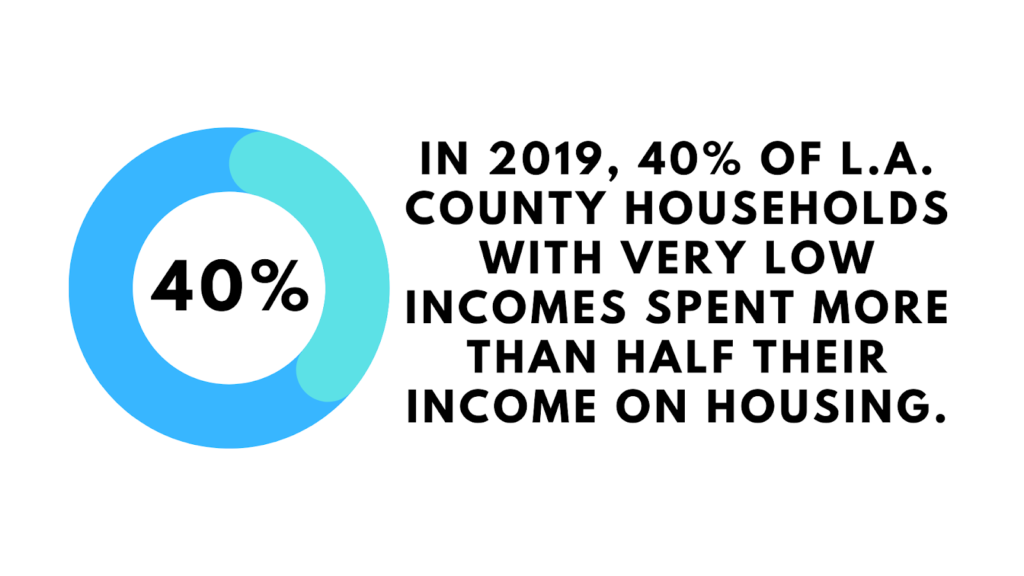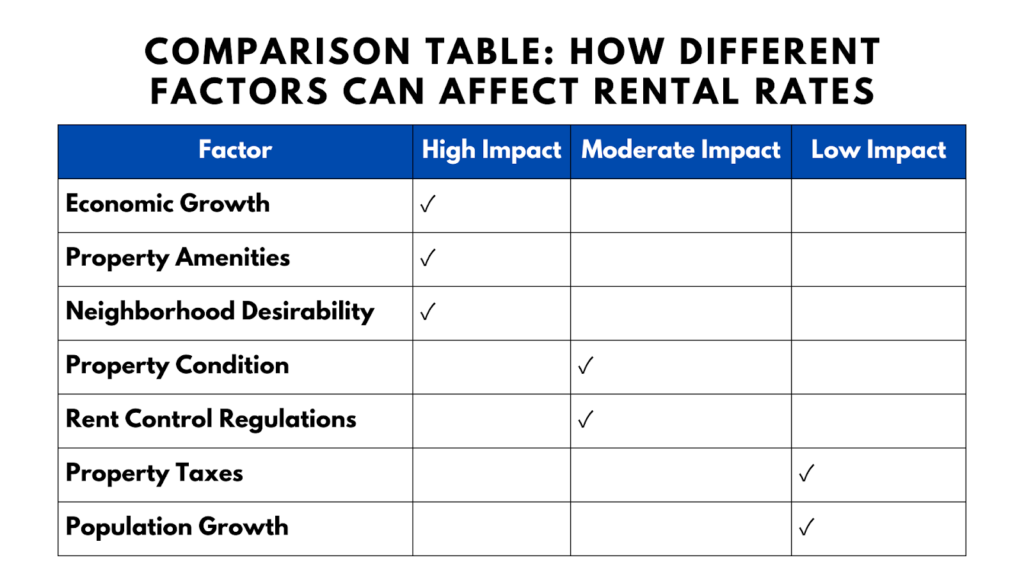Last Updated on July 16, 2024 by Asfa Rasheed
If you’re looking to rent a property or invest in a rental property in Los Angeles, understanding the factors that influence rental rates is crucial. Determining the right rental price goes beyond just considering the size and location of the property. It involves a complex interplay of various economic, property-specific, regulatory, and demographic factors.
In the dynamic housing market of Los Angeles, where demand often outweighs supply, rental rates can fluctuate significantly across neighborhoods and property types. Failing to account for the multitude of factors that shape these rates can lead to pricing your rental property too high or too low, resulting in prolonged vacancies or missed opportunities for maximizing returns.
As a prospective renter or landlord, navigating this intricate landscape requires a comprehensive understanding of the forces at play.
Table of Contents
Economic Factors
A. Demand and Supply Dynamics
The law of supply and demand is a fundamental driver of rental rates. In Los Angeles, where the job market is thriving, and the population continues to grow, the demand for rental properties remains high. However, the supply of available rental units may not be keeping pace, leading to increased competition and higher rental rates.
This imbalance between supply and demand can be observed in various neighborhoods across the city.
For instance, areas like Downtown Los Angeles, Hollywood, and Santa Monica, which have experienced significant development and population growth, often face a scarcity of rental units, driving up prices. The housing shortage is particularly prevalent among lower-income households. In 2019, 40% of L.A. County households with very low incomes spent more than half their income on housing.

Conversely, areas with a surplus of available rentals may experience more moderate or even declining rental rates due to the increased competition among landlords.
For property owners in Los Angeles seeking to navigate these demand and supply dynamics effectively, partnering with a reputable property management company can be invaluable.Property management in Los Angeles firms have in-depth knowledge of local market conditions and can guide them on setting competitive rental rates, maximizing occupancy, and maintaining a steady stream of qualified tenants.
B. Economic Growth and Employment Opportunities
A strong local economy and ample employment opportunities often translate into higher rental rates. As more people move to Los Angeles for job prospects, the demand for rental housing increases, allowing landlords to command higher prices. This trend is particularly evident in neighborhoods surrounding major employment hubs, such as Century City, Westwood, and Downtown Los Angeles.
Conversely, an economic downturn or job losses can lead to a decrease in rental demand and subsequent downward pressure on rates. During periods of economic uncertainty or recession, renters may seek more affordable housing options, forcing landlords to adjust their prices to attract and retain tenants.
Property Characteristics
A. Property Type and Size
The type and size of a rental property significantly influence its rate. Generally, larger properties, such as single-family homes, command higher rents than smaller apartments or condos. This is because larger properties offer more living space and often come with additional amenities like private yards or garages.
Additionally, unique property types like lofts or townhouses may fetch premium rates due to their appeal and scarcity. These properties cater to specific lifestyle preferences and may be in high demand among particular renter demographics, allowing landlords to charge higher rents.
B. Amenities and Features
Amenities and features play a crucial role in determining rental rates. Properties with desirable amenities like covered parking, in-unit laundry facilities, or a private outdoor space can command higher rents. Renters are often willing to pay a premium for these conveniences, as they enhance their living experience and add value to the property.
Similarly, upgraded features such as stainless steel appliances, hardwood floors, or modern finishes can justify higher rental prices. These upgrades not only improve the aesthetic appeal of a property but also contribute to a sense of luxury and quality that many renters seek.
Location Factors
A. Neighborhood Desirability
The desirability of a neighborhood is a significant factor in rental rate determination. Properties located in highly sought-after areas with excellent schools, low crime rates, and proximity to amenities like parks, shopping centers, and public transportation tend to command higher rents.
B. Local Market Trends
Staying informed about local market trends is essential for accurately pricing rental properties. In rapidly gentrifying neighborhoods, rental rates may rise faster than the overall market. Conversely, areas experiencing economic decline or population loss may see a decrease in rental rates.
Regulatory and Legal Influences
A. Rent Control and Regulations
In Los Angeles, rent control laws can significantly impact rental rates for certain types of properties. Landlords must comply with these regulations, which may limit their ability to raise rents beyond a certain percentage annually.
B. Taxes and Fees
Property taxes, homeowners association fees, and other local fees can directly influence the rental rates landlords set. Higher taxes and fees may prompt landlords to increase rents to offset these costs and maintain profitability.
Property Condition and Maintenance
A. Property Condition
The overall condition of a rental property is a critical factor in determining its rental rate. Well-maintained properties with no significant defects or repair needs can command higher rents than those in poor condition.
B. Renovations and Improvements
Investing in renovations and improvements can be a strategic way to increase a property’s rental rate. Upgrades such as a renovated kitchen or bathroom, new flooring, or energy-efficient appliances can make a property more attractive to renters and justify higher rental prices.
Demographic Factors
A. Target Tenant Profile
Understanding the demographic characteristics of potential renters in your target area is essential. Factors like age, income level, and family status can influence rental preferences and pricing. Tailoring your rental property to meet the needs of your target tenant market can help you set competitive rental rates.
B. Population Growth and Migration
Population growth and migration patterns can significantly impact rental demand and rates. Areas experiencing an influx of new residents may see an increase in rental rates due to higher demand. Conversely, areas with a declining population may face downward pressure on rental rates.

As this table illustrates, factors like economic growth, property amenities, and neighborhood desirability can have a high impact on rental rates, while factors like property condition and rent control regulations may have a moderate impact. Property taxes and population growth may have a lower impact on rental rates for a two-bedroom apartment in Los Angeles.
Frequently Asked Questions (FAQs)
In a competitive rental market, being an informed renter is key to negotiating lower rates. Research comparable properties in the area, highlight any shortcomings or lack of amenities in the rental unit you’re interested in and be prepared to act quickly when a well-priced property becomes available.
Setting rental rates too high can lead to prolonged vacancies and lost income. Conversely, setting rates too low can result in missed opportunities for maximizing returns and may attract tenants who cannot afford the rent long-term.
Assessing fair market value requires researching recently rented comparable properties in your target area, considering factors like property type, size, amenities, and location. Working with a knowledgeable real estate professional or consulting rental data sources can also help you accurately determine fair market rental rates.
Conclusion
As a prospective renter or landlord in Los Angeles, understanding the complex interplay of factors that influence rental rates is crucial. From economic conditions and property characteristics to location factors, regulatory influences, and demographic trends, each element plays a role in shaping rental prices.
Whether you’re seeking a new rental home or aiming to maximize returns on your investment property, taking the time to research and consider these multifaceted factors can help you make informed decisions and navigate the dynamic Los Angeles rental market with confidence.





















